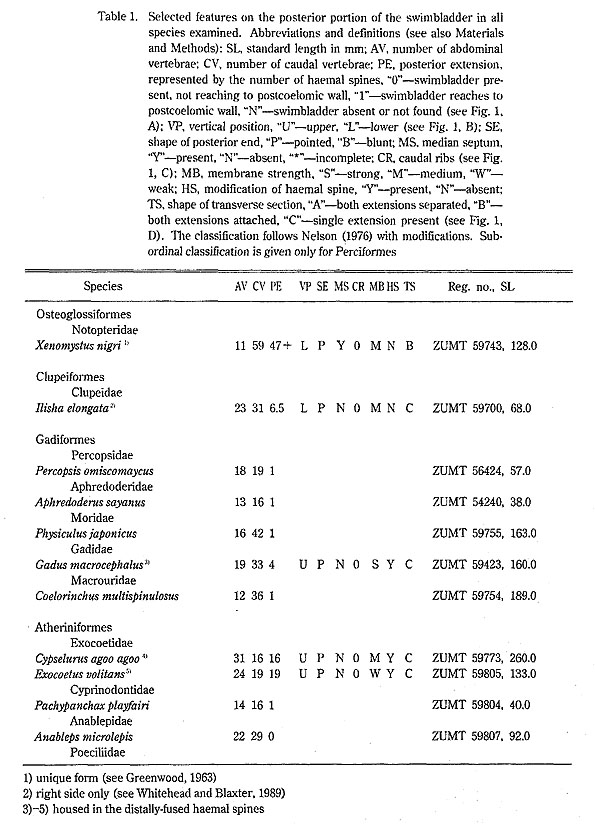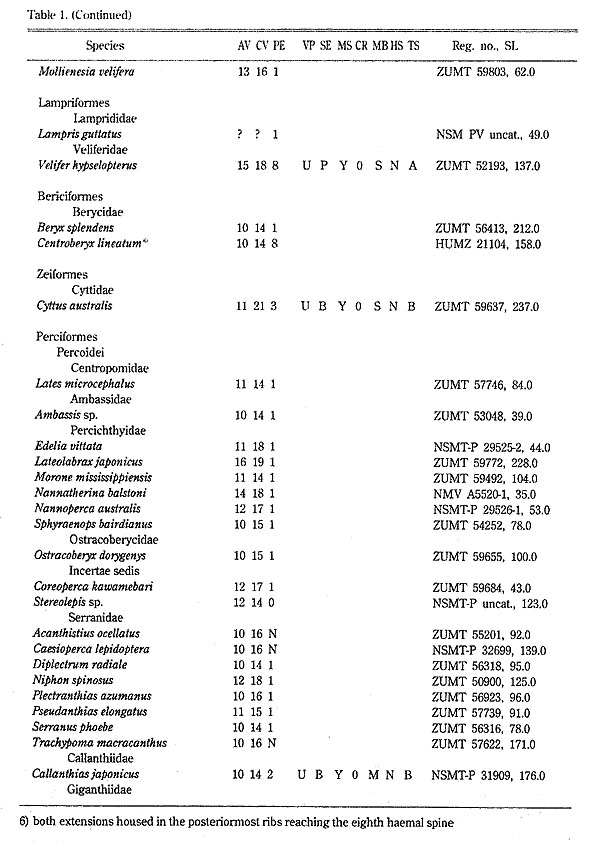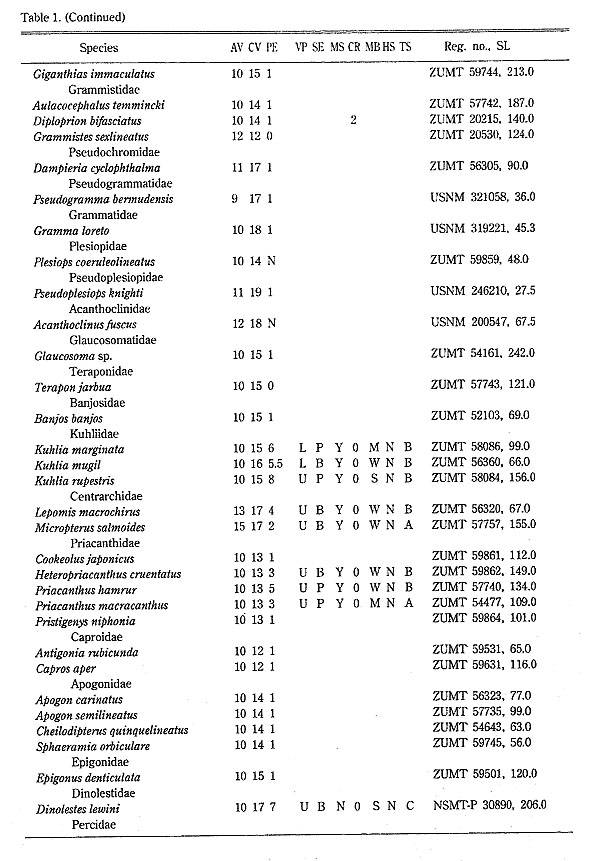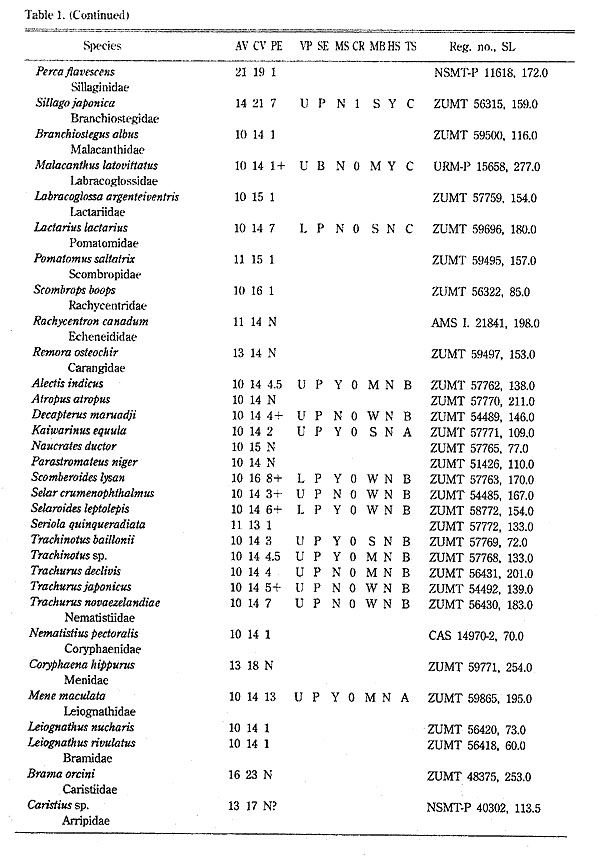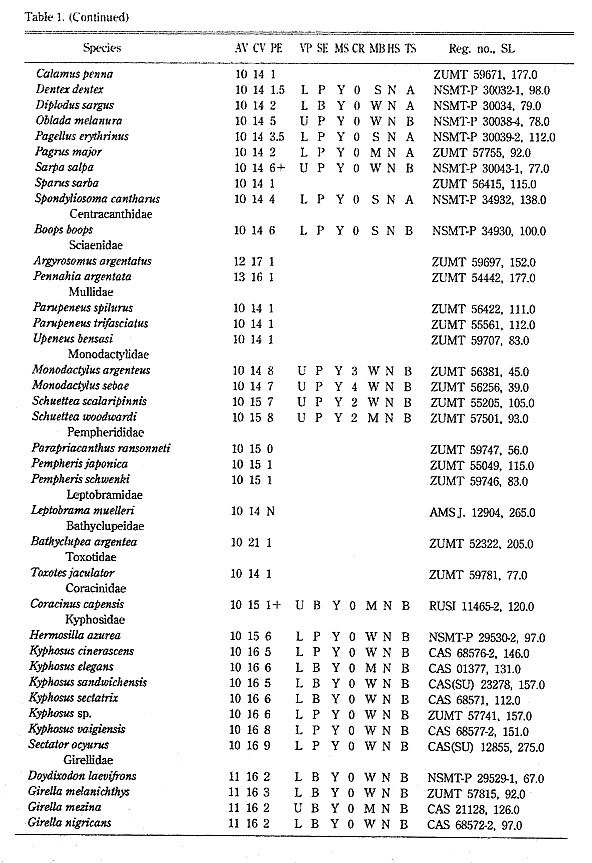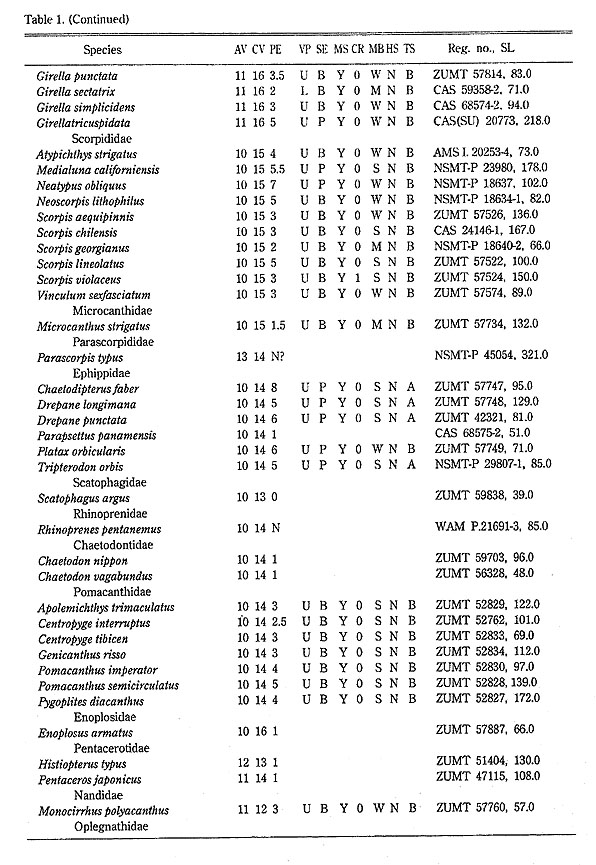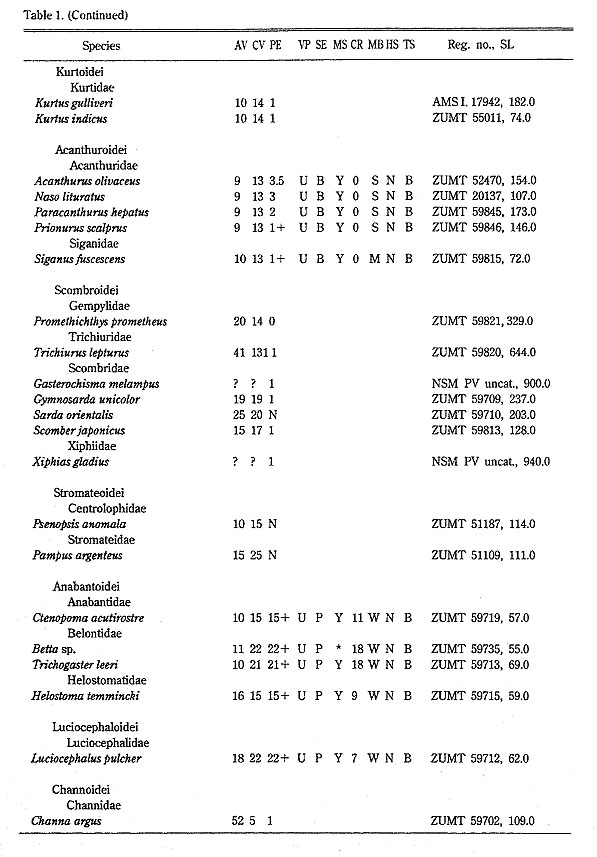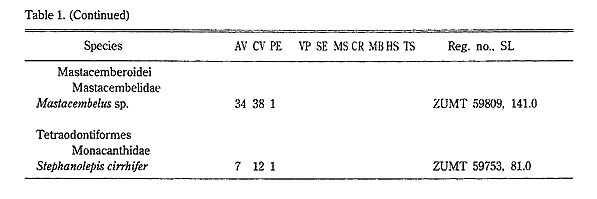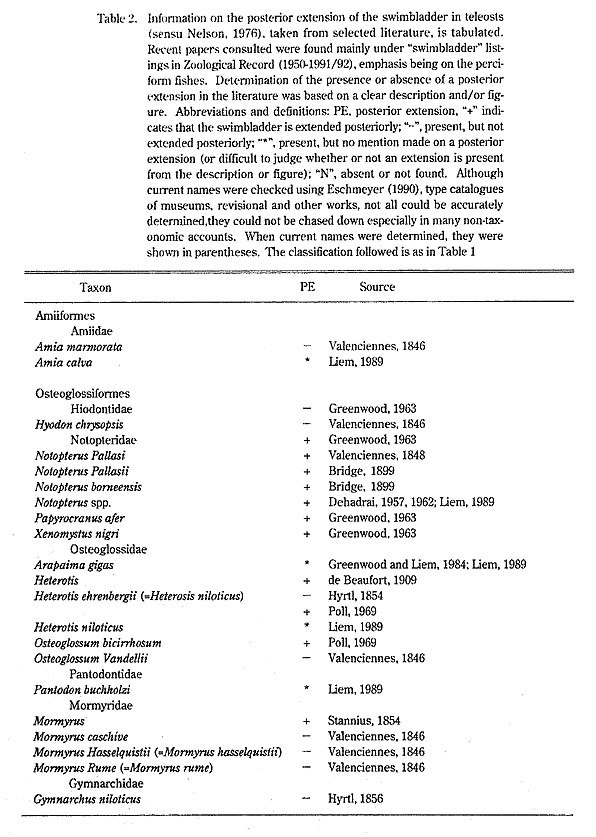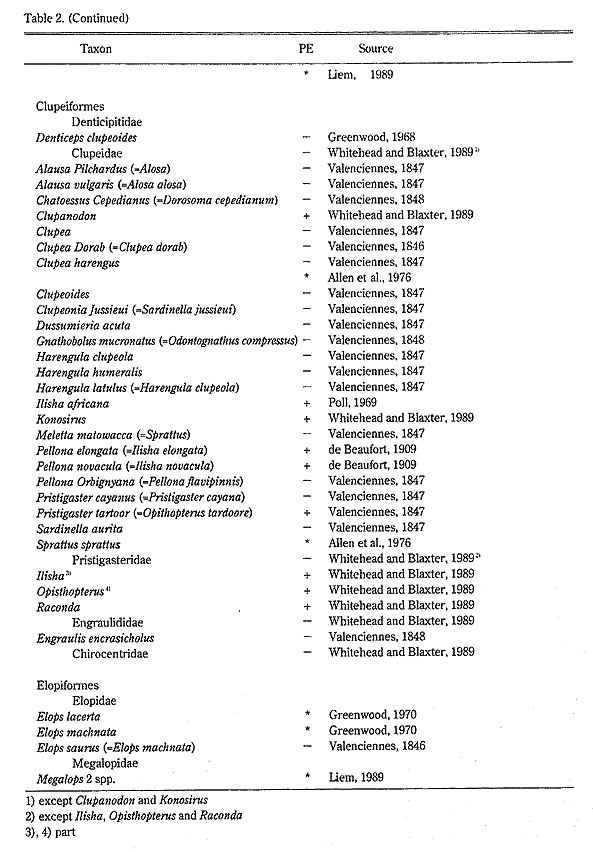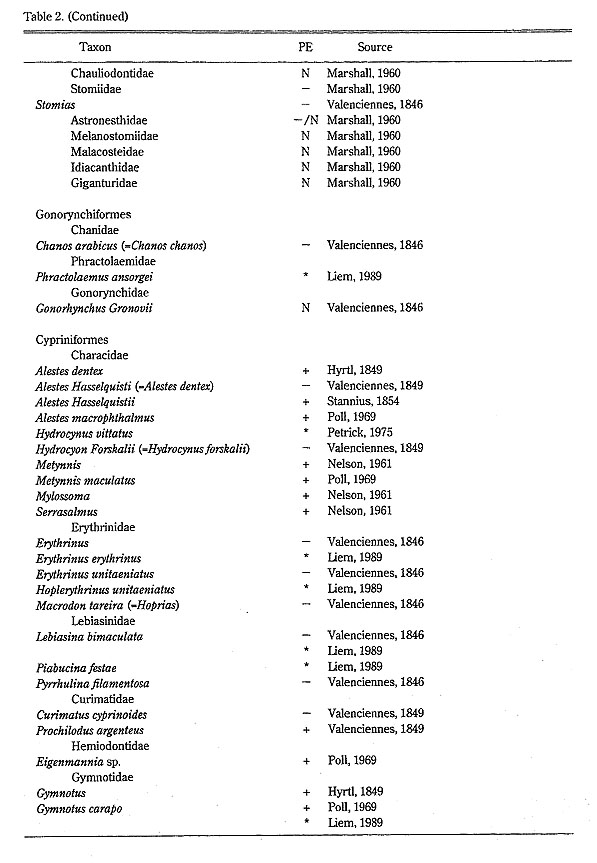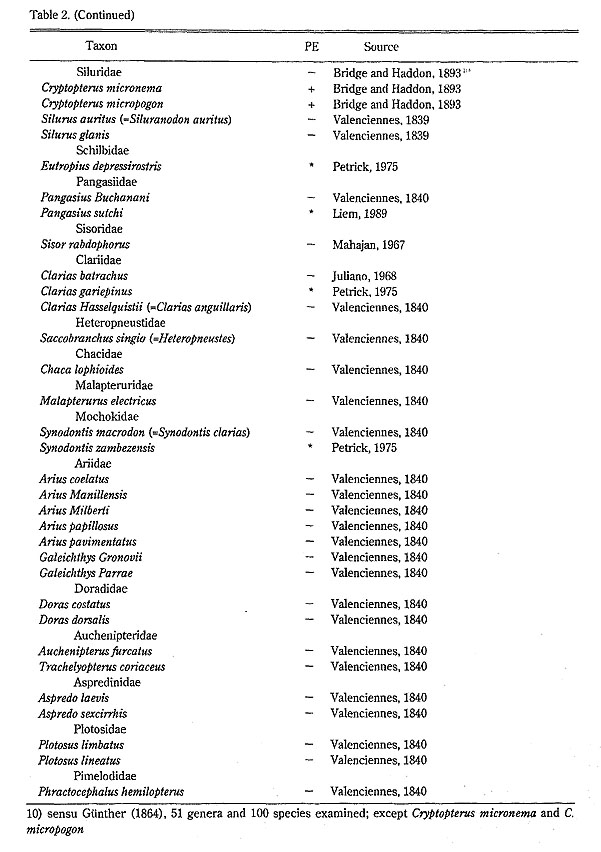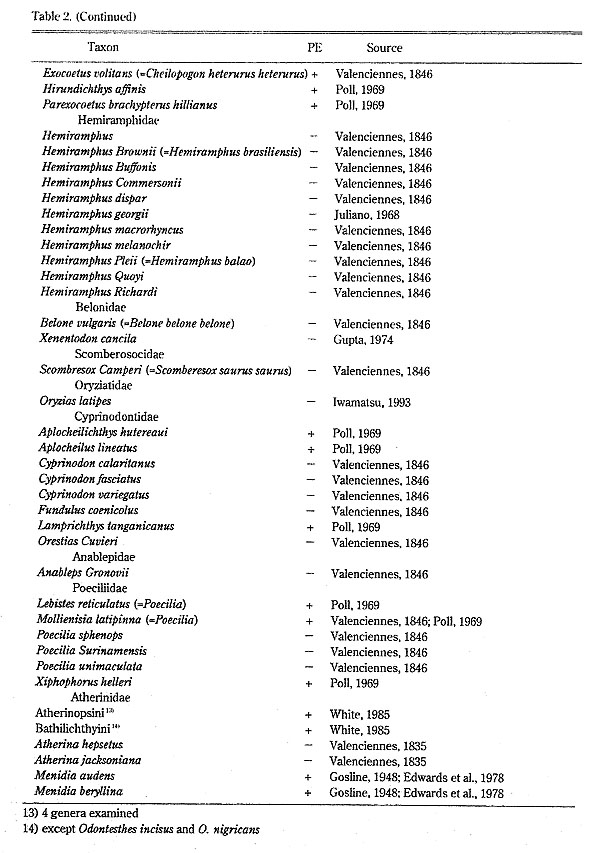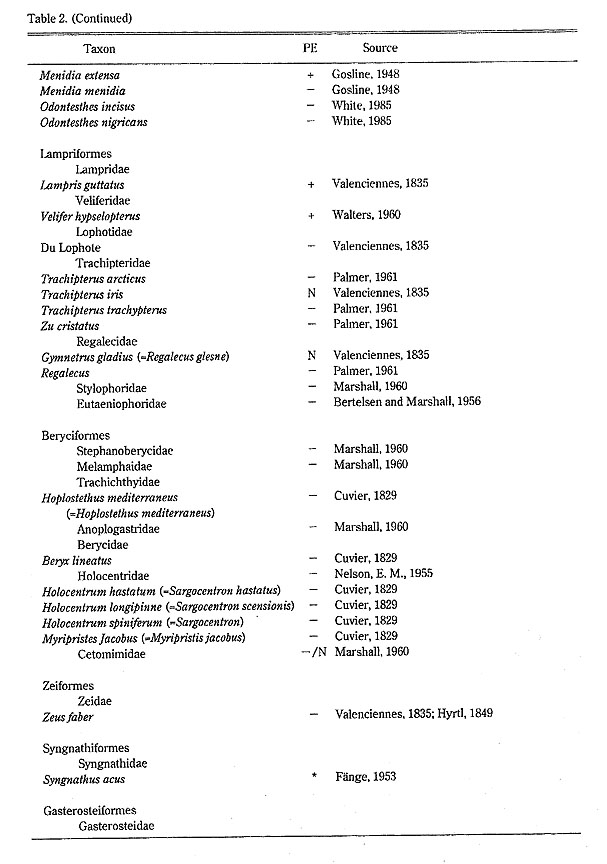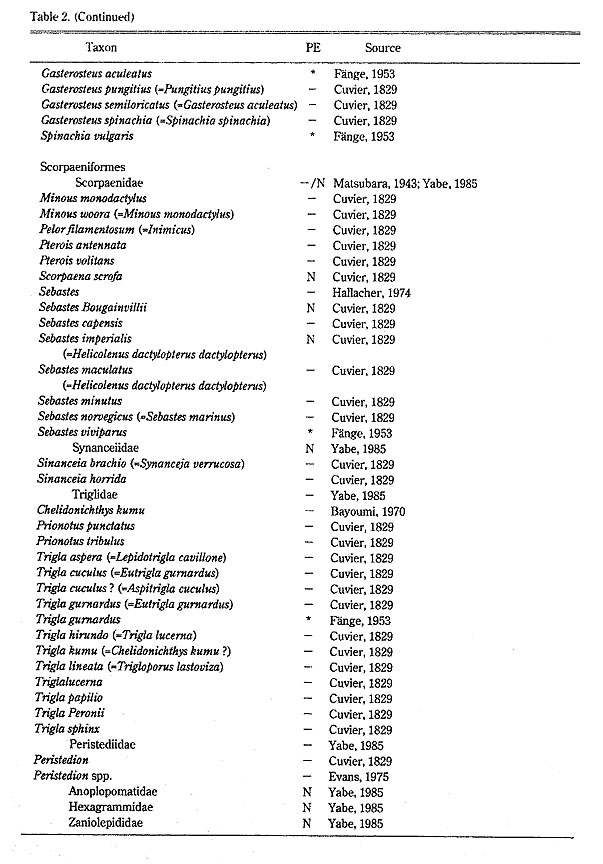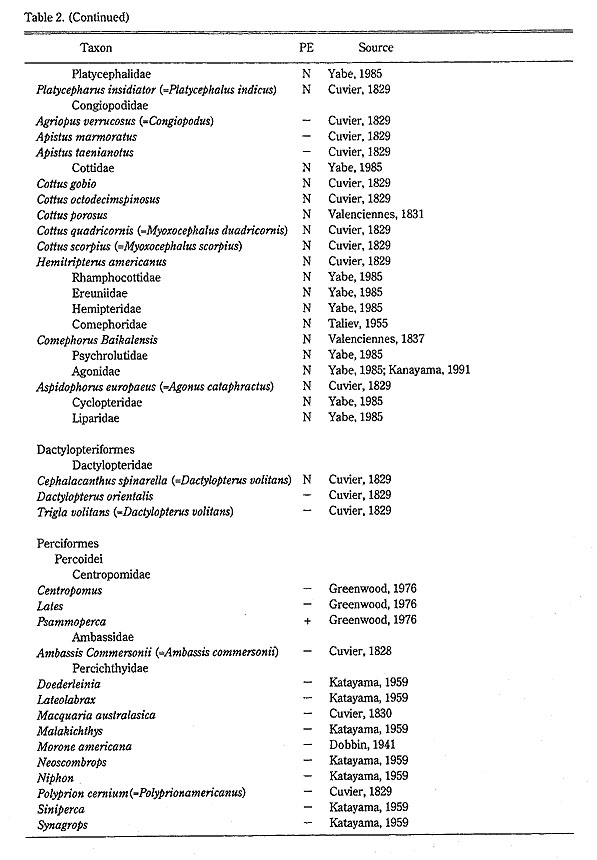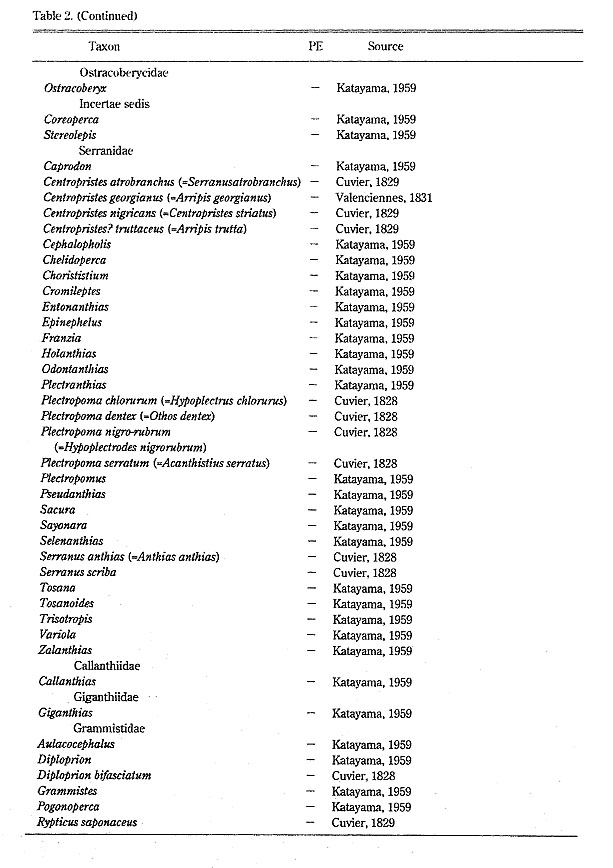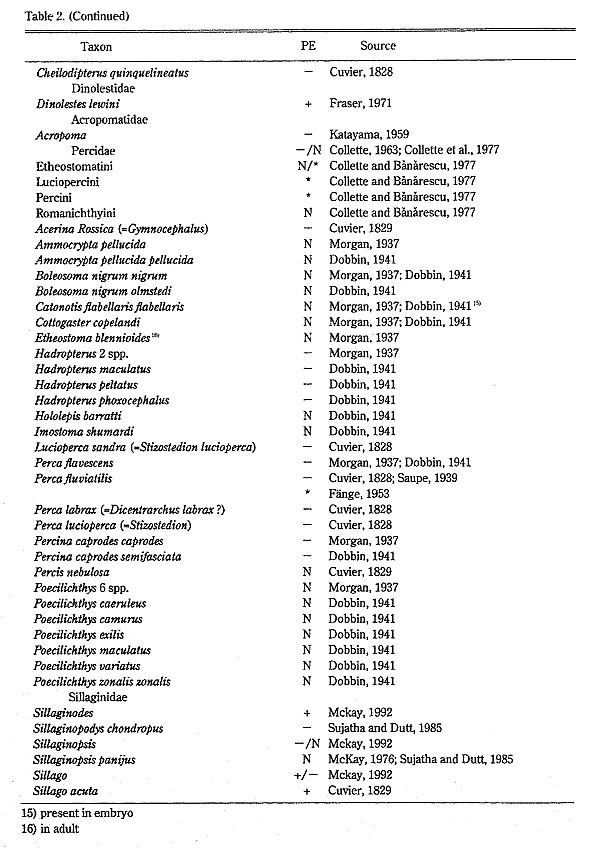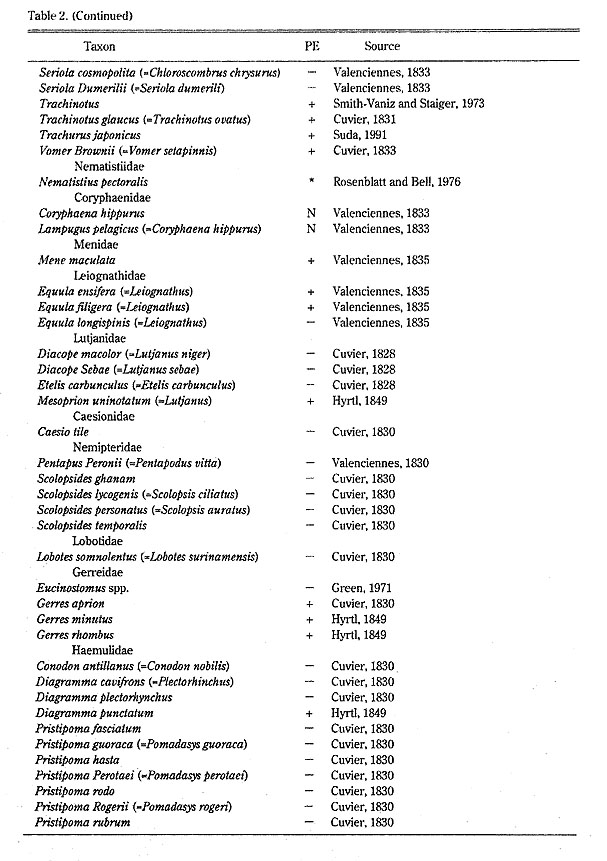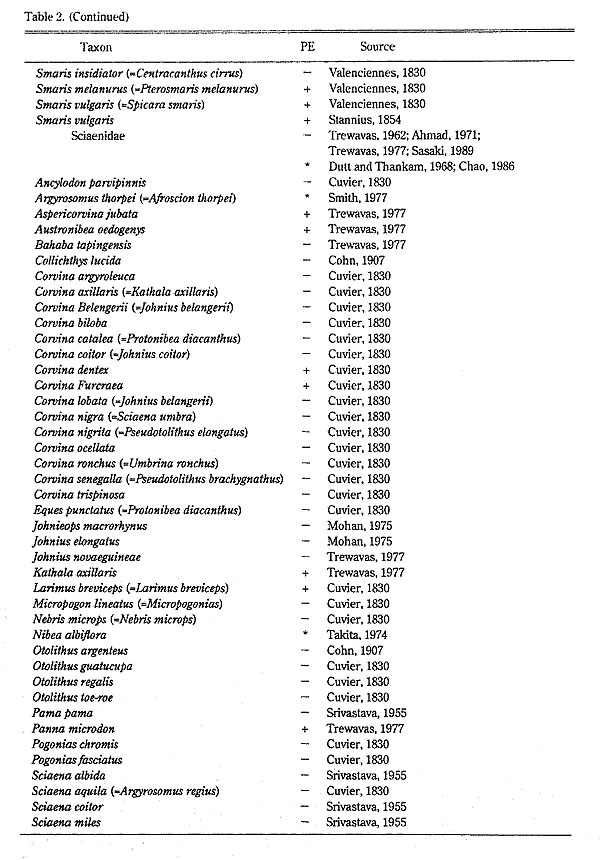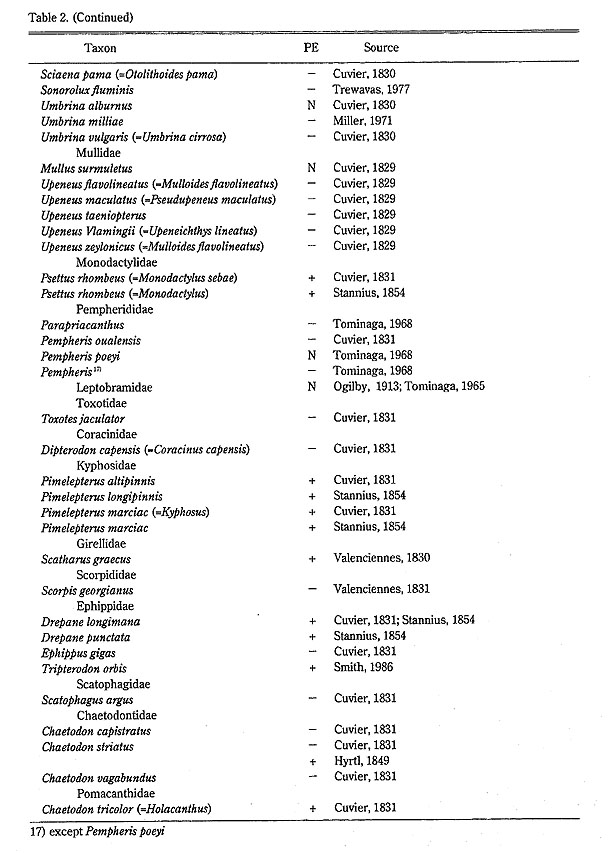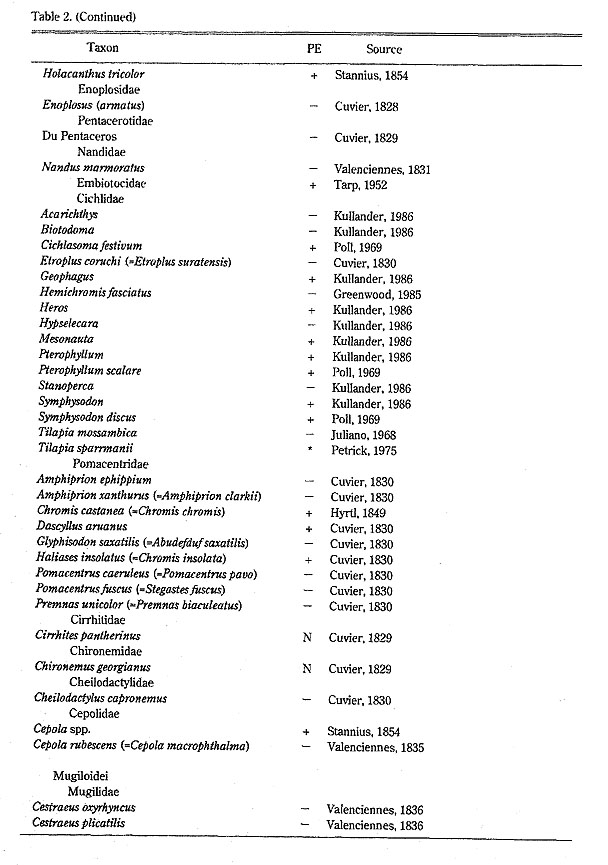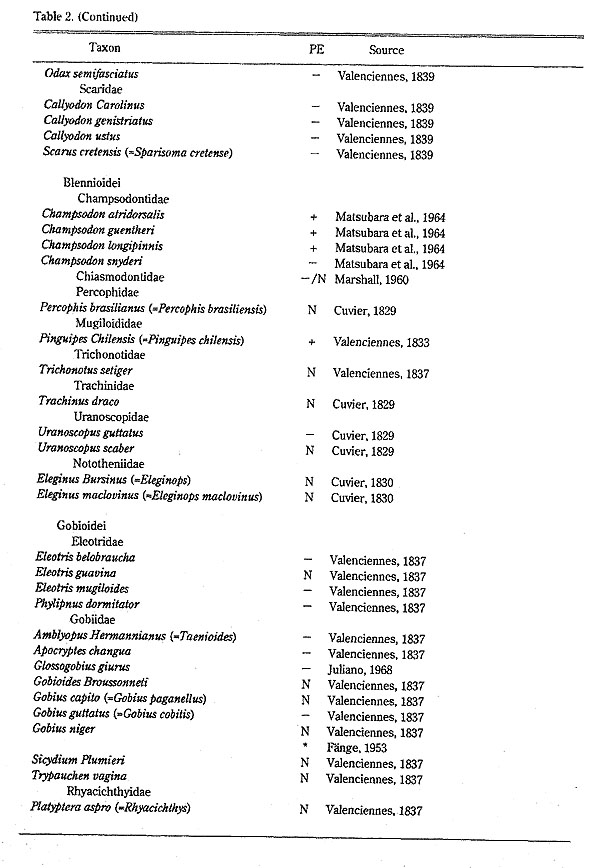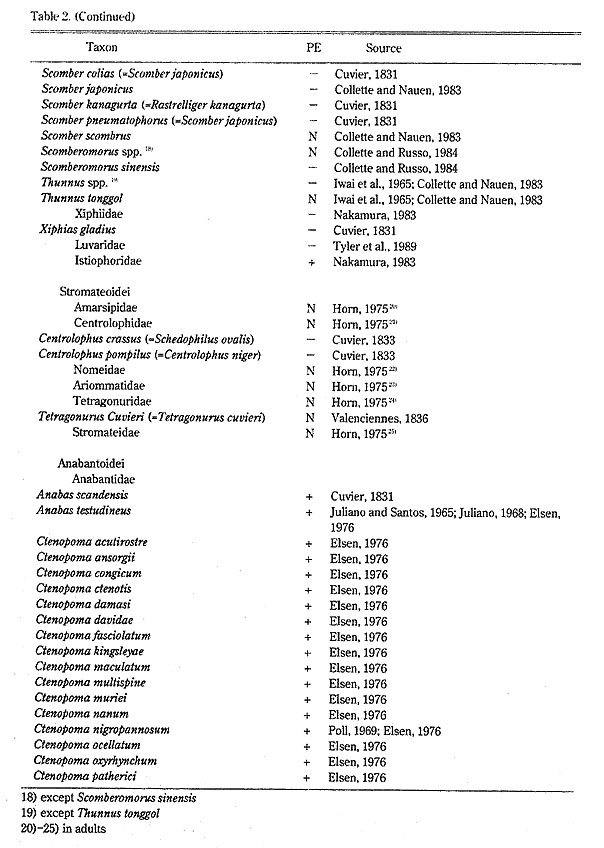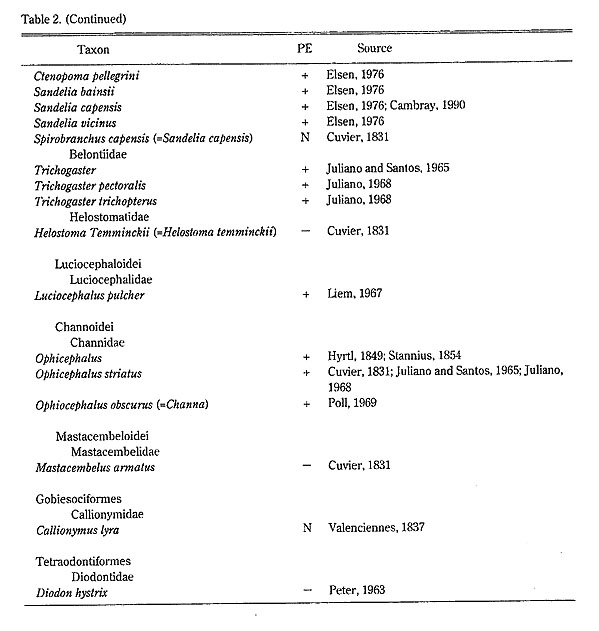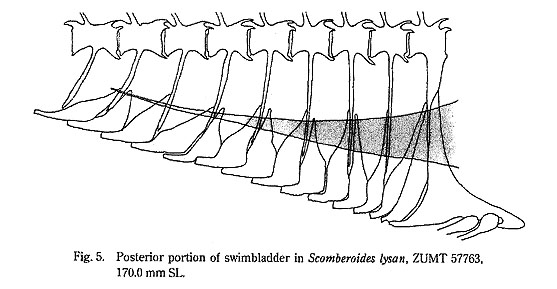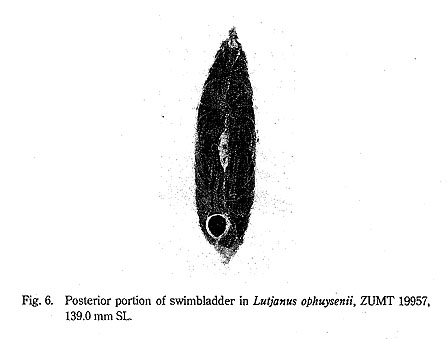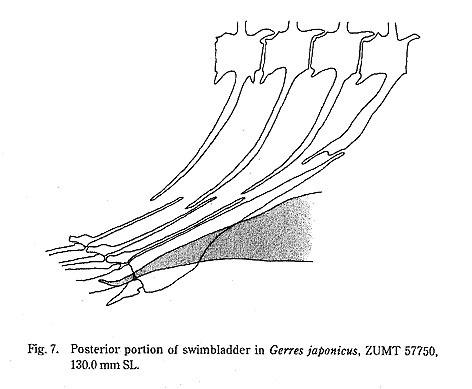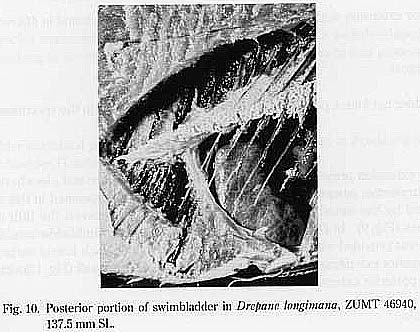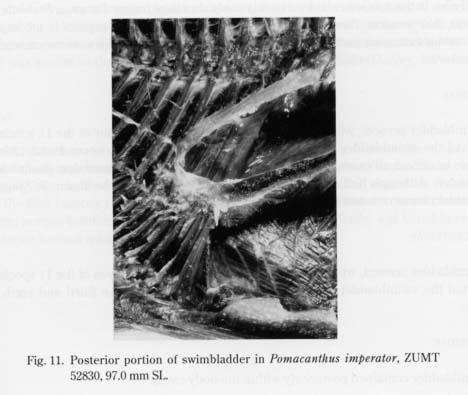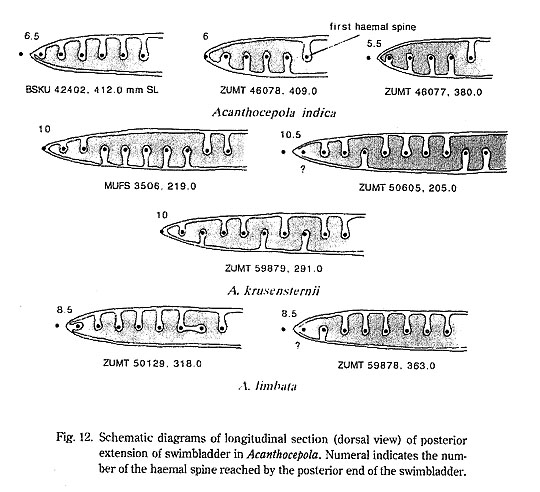Results and Comments
|
Selected features of the posterior extension of the swimbladder and related structures in percoids and some other teleosts examined here are shown in Table 1. Literature information on the presence or absence of a posterior swimbladder extension in teleosts is tabulated in Table 2. Comments are restricted to each percoid family or, in a few cases, to each genus.
CENTROPOMIDAEA slight posterior extension in the left side of the body only has been reported in Psammoperca (see Greenwood, 1976), but no posterior extensions have been found in the other two genera, Centropomus and Lates (Greenwood, 1976; this study). AMBASSIDAEPosterior extension absent. PERCICHTHYIDAEThe swimbladder was contained posteriorly within the body cavity in all species examined in this study and elsewhere. According to Katayama (1959), the posterior end of the swimbladder extended into the hollow space of the first anal-fin proximal pterygiophore in Lateolabrax, Acropoma (included in Acropomatidae in this study) and Malakichthys elegans. This was confirmed in Lateolabrax japonicus. Such a modification in the anal-fin proximal pterygiophore has been reported in Eucinostomus (Gerreidae) (Cuvier, 1830; Jordan, 1895; Green, 1971), Calamus (Sparidae) (Cuvier, 1829; this study) and Polymixia japonica (Polymixiidae, Polymixiiformes) (Starks, 1908; confirmed in ZUMT uncatalogued specimen, 180 mm SL). OSTRACOBERYCIDAEPosterior extension absent. COREOPERCAPosterior extension absent. STEREOLEPISPosterior extension absent. SERRANIDAEPosterior extension absent in all species examined here and elsewhere. In Acanthistius, Caesioperca and Trachypoma, a swimbladder was not found. CALLANTHIIDAEIn Callanthias, although Katayama (1959:165, fig.35H) stated "the organ [=swimbladder] … occupies the entire breadth of the [body] cavity", a slight posterior extension reaching to the second haemal spine was found in this study. SYMPHYSANODONNo specimens available for study. GIGANTHIIDAEPosterior extension absent. GRAMMISTIDAEPosterior extension absent. Diploprion bifasciatum is unique among teleosts in having two caudal ribs attached laterally to the first and second haemal spines (Fig. 2).
PSEUDOCHROMIDAEPosterior extension absent. PSEUDOGRAMMIDAEPosterior extension absent. GRAMMIDAEPosterior extension absent. PLESIOPIDAESwimbladder absent in Plesiops. PSEUDOPLESIOPIDAEPosterior extension absent. ANISOCHROMIDAENo specimens available for study. ACANTHOCUNIDAESwimbladder absent. GLAUCOSOMATIDAEPosterior extension absent in Glaucosoma. DINOPERCIDAESwimbladder present, but no mention made on posterior extension by Heemstra and Hecht (1986). TERAPONIDAEPosterior extension absent. BANJOSIDAESwimbladder contained posteriorly within the body cavity. KUHLIIDAEPosterior extension present in all species of Kuhlia examined here and elsewhere. Three species of Kuhlia examined had the Swimbladder extended posteriorly to between the fifth and sixth to the eighth haemal spines. Although Cuvier (1829) reported Kuhlia rupestris as lacking a posterior extension, the swimbladder of this species was found to extend posteriorly to the eighth haemal spine. CENTRARCHIDAEPosterior extension present in almost all species studied here and elsewhere. In two species examined the swimbladder extended posteriorly to between the second and fourth haemal spines. In Micropterus salmoides the swimbladder has a slight posterior extension, though Cuvier (1829) reported such to be absent. Huro salmoides and Micropterus pseudoplites vary intraspecifically in the presence or absence of a posterior extension (Dobbin, 1941). PRIACANTHIDAEPosterior extension present in Heteropriacanthus and Priacanthus; absent in Cookeolus and Pristigenys (Starnes, 1988; this study). In the former two genera, the swimbladder extends posteriorly to between the third and fifth haemal spines. In Heteropriacanthus cruentatus, a posterior extension was not described by Fitch and Crooke (1984), although later found by Starnes (1988) and in the present study. Although a posterior extension was reported absent in Priacanthus arenatus by Cuvier (1829), Starnes (1988) demonstrated its presence in species of Heteropriacanthus and Priacanthus. CAPROIDAESwimbladder contained posteriorly within the body cavity. APOGONIDAEPosterior extension absent. EPIGONIDAEPosterior extension absent. DINOLESTIDAEA strongly-membraned posterior extension reaches to the seventh haemal spine. Fraser (1971:161) stated "posteriorly the finely tapered swimbladder extends past the haemal pterygiophores only on the left side." This was confirmed by the present study, which also revealed that the anterior 17 proximal pterygiophores of the anal fin curved to the right, allowing the swimbladder to extend in a straight line just along the tips of the haemal spines. ACROPOMATIDAEAccording to Katayama (1959), a posterior extension is absent in Acropoma. For modification of the first anal-fin proximal pterygiophore, see Percichthyidae. PERCIDAESwimbladder well-developed, reduced or absent. When present, a posterior extension is absent. SILLAGINIDAEAccording to McKay (1992), the swimbladder is either absent, poorly developed, or highly complex with anterior and lateral extensions projecting well into the caudal region. The anterior haemal spines are modified where they contact the posterior extension of the swimbladder in many species (Sano and Mochizuki, 1984; McKay, 1992). In species of Sillago (Sillago) with a double posterior extension, one extension is usually longer than the other (McKay, 1976,1992; Sano and Mochizuki, 1984; Sujatha and Dutt, 1985). In Sillago japonica, the swim-bladder extends posteriorly to the seventh haemal spine, with an associated caudal rib (Sano and Mochizuki, 1984; this study). BRANCHIOSTEGIDAEPrevious reports indicated a swimbladder to be present, with or without a posterior extension, except in three species studied by Cuvier (1830), Valenciennes (1833) and Poll (1969). According to Dooley (1978), however, and confirmed here, a swimbladder is always com-pletely contained posteriorly within the body cavity. MALACANTHIDAESwimbladder present, with a single, small, rounded posterior extension. Dooley (1978) stated "the first haemal spine-with parapophyses fused only at their tips forming a wish-bone-shaped arch through which swimbladder protrudes posteriorly." This was noted in Malacanthus. along with a similar structure in the anterior four haemal spines in Pseudocepola taeniosoma (Owstoniidae). LABRACOGLOSSIDAESwimbladder contained posteriorly within the body cavity. LACTARIIDAEThe single, strongly-membraned posterior extension in this family is unique among teleosts (Leis, 1994; this study), avoiding the right side at the first anal-fin proximal pterygiophore (attached to the first haemal spine), running posteriorly in a straight line along the tips of the second and third haemal spines, curving to the right under the midpoint between the third and fourth haemal spines, and ending wholly on the right side of the body. Associated with this, the fifth to 14th anal-fin proximal pterygiophores curve slightly to the left (Figs. 3 & 4).
POMATOMIDAEPosterior extension absent. SCOMBROPIDAESwimbladder contained posteriorly within the body cavity. RACHYCENTRIDAESwimbladder absent. ECHENEIDIDAESwimbladder absent. CARANGIDAESwimbladder usually present, but absent in Atropus atropus, Naucrates ductor and Parastro-mateus niger. In most species possessing a swimbladder, a posterior extension is present (Fig.5), reaching to between the second and seventh haemal spines in 11 of 14 species examined in this study. The posterior extension of the swimbladder is perforated by haemal spines in Decapterus, Selar and Trachurus (see Suda, 1991).
NEMATISTIIDAEPosterior extension absent. CORYPHAENIDAESwimbladder absent. MENIDAEFinely tapered swimbladder extensions run posteriorly along the haemal spine bases to the penultimate vertebra. LEIOGNATHIDAEPosterior extension present or absent in Leiognathus; absent in L. nucharis and L. rivulatus examined in this study. BRAMIDAESwimbladder absent. CARISTIIDAESwimbladder not found, possibly due to the fully matured ovary in the specimen examined. ARRIPIDAESwimbladder contained posteriorly within the body cavity. EMMELICHTHYIDAEPosterior extension absent. LUTJANIDAEPosterior extension present, in five of 15 species examined in this study and one of four examined elsewhere (Cuvier, 1828; Hyrtl, 1849), or absent. Where present in species examined here, the swimbladder extended to between the first (slightly beyond) and tenth haemal spines. Lutjanus ophuysenii and L. vitta are unique within the genus in having a single posterior portion running posteroventrally to between the fourth and 5.5th haemal spines on the right side of the body (Fig. 6). Consequently, the anterior three or four anal-fin proximal pterygiophores curve slightly to the left.
CAESIONIDAEPosterior extension absent. NEMIPTERIDAEPosterior extension absent. LOBOTIDAEPosterior extension absent. GERREIDAEIn two species of Gerres examined in this study, a strongly-membraned swimbladder ran posteriorly along the postcoelomic wall and the first anal-fin proximal pterygiophore; its posterior portion tapered, dividing into two parts below the third caudal vertebra, each part then extending posteroventrally to the base of the third anal spine. The distal part of the extension was visible through the scales covering the base of the anal spine (Fig. 7). In this study, the swimbladder is treated as lacking a posterior extension (Table 1). Data for the three species of Gerres reported by Cuvier (1930) and Hyrtl (1849) were not considered here. In Eucinostomus, the posterior end of the swimbladder enters into the hollow space of the first anal-fin proximal pterygiophore (Green, 1971) (see Percichthyidae).
HAEMULIDAESwimbladder contained posteriorly within the body cavity in almost all species examined here and elsewhere. A slight. posterior extension, beyond the first haemal spine at most, was found in Parapristipoma trilineatum. Diagramma punctatum was reported as having a posteriorly extended swimbladder by Hyrtl (1849). LETHRINIDAEPosterior extension present in Lethrinus except L. olivaceus (see Valenciennes, 1830) and L. spp. (see Stannius, 1854), but absent in Gnathodentex and Gymnocranius. In Lethrinus nematacanthus examined here, the swimbladder extended posteriorly to the fourth haemal spine. PENTAPODIDAEPosterior extension absent. SPARIDAEPosterior extension present or absent. In eight of 10 species (10 genera) examined in this study, the swimbladder extended to between the first (slightly beyond) and sixth (also beyond) haemal spines. In Dentex dentex, Diplodus sargus and Pagellus erythrinus, a posterior extension was observed, although Valenciennes (1830) reported a posterior extension to be absent. In Calamus, the posterior end of the swimbladder extends into the hollow space of the first anal-fin proximal pterygiophore (Cuvier, 1829; this study) (see Percichthyidae). CENTRACANTHIDAECentracanthids, with the exception of Spicara maena maena (see Valenciennes, 1830) and Centracanthus cirrus (see Valenciennes, 1830), have a swimbladder with a posterior extension. In Boops boops examined in this study, the swimbladder extended to the sixth haemal spine. SCIAENIDAEMany works deal with the swimbladder in this family, because of its taxonomic significance. According to the most recent, extensive study (Sasaki, 1989), a posterior extension is absent. MULLIDAEA swimbladder is contained posteriorly within the body cavity in all species examined here and elsewhere, except in Mullus surmuletus, which lacks a swimbladder (Cuvier, 1829). MONODACTYLIDAEIn four species examined in this study, the swimbladder had a well-developed posterior extension reaching to the seventh or eighth haemal spine, with two to four associated caudal ribs (Fig. 8).
PEMPHERIDIDAESwimbladder contained posteriorly within the body cavity, except in Pempheris poeyi which lacks a swimbladder (Tominaga, 1968). LEPTOBRAMIDAESwimbladder absent. BATHYCLUPEIDAEPosterior extension absent. TOXOTIDAEPosterior extension absent. CORACINIDAEAlthough Cuvier (1831) reported Coracinus capensis as lacking a posterior extension, such was observed in this study to extend slightly beyond the first haemal spine. KYPHOSIDAEPosterior extension present, extending posteriorly to between the fifth and ninth haemal spines in the species examined here. GIRELLIDAEPosterior extension present, extending posteriorly to between the second and fifth haemal spines in the species examined here. SCORPIDIDAEPosterior extension present In the species examined here, the swimbladder extended pos-teriorly to between the second and seventh haemal spines. In Scorpis georgianus, a slight posterior extension was observed, although Valenciennes (1831) reported the species as lacking a posterior extension. Scorpis violaceus is unique among scorpidids in having a caudal rib. MICROCANTHIDAEA posterior extension slightiy beyond the first haemal spine was found in Microcanthus strigatus. PARASCORPIDIDAESwimbladder not found, possibly due to the fully matured ovary in the specimen examined. EPHIPPIDAEPosterior extension present in almost all species examined here and elsewhere, although absent in Parapsettus panamensis and Ephippus gigas. Species examined in this study were characterized by the swimbladder extending posteriorly to between the fifth and eighth haemal spines (Fig. 9). In Drepane longimana, that part of the swimbladder contained in the body cavity was provided with many finger-like branches along each lateral surface, some of the most posterior extending posteriorly beyond the postcoelomic wall (Fig. 10). In D. punctata, the right posterior extension was longer than the left.
SCATOPHAGIDAEPosterior extension absent. RHINOPRENIDAESwimbladder absent. CHAETODONTIDAEPosterior extension absent. Although Cuvier (1831) noted the swimbladder of Chaetodon striatus as lacking a posterior extension, Hyrtl (1849) reported to the contrary. POMACANTHIDAEPosterior extension present in all species examined here and elsewhere. Species examined here had a strongly-membraned extension reaching to between the second and third to the fifth haemal spines (Fig. 11).
ENOPLOSIDAEPosterior extension absent. PENTACEROTIDAESwimbladder contained posteriorly within the body cavity. NANDIDAEA posterior extension as far as the third haemal spine was found in Monocirrhus polyacanthus. However. no such extension was reported in Nandus marmoratus by Valenciennes (1831). OPLEGNATHIDAEA posterior extension reaching slightly beyond the first haemal spine was found in both Oplegnathus fasciatus and O. punctatus. EMBIOTOCIDAEA well-developed, although slender, posterior extension present (Tarp, 1952; this study). reaching to between the sixth and 22nd haemal spines and being associated with one to 10 caudal ribs, in the species examined in this study. In Brachyistius, Ditrema, Embiotoca, Hyste-rocarpus, Micrometrus, Neoditrema and Phanerodon, the median septum is incomplete and the posterior extension partially perforated by haemal spines, similar to some carangids, such as Trachurus. CICHLIDAESwimbladder present, with or without a posterior extension. Four of the 11 species examined had the Swimbladder extending posteriorly to between the second and 12th haemal spines. In almost all cases, some caudal ribs accompanied the extension (Kullander, 1986; this study). Although Kullander (1986) considered caudal ribs to be absent in Symphysodon, two caudal ribs were found in S. discus during this study. POMACENTRIDAESwimbladder present, with or without a posterior extension. Seven of the 11 species examined had the swimbladder extending posteriorly to between the third and sixth haemal spines. GADOPSIDAESwimbladder contained posteriorly within the body cavity. CIRRHITIDAESwimbladder absent in a species of Cirrhites examined by Cuvier (1829). CHIRONEMIDAESwimbladder absent in Chironemus. APLODACTYLIDAESwimbladder absent in Aplodactylus arctidens. CHEILODACTYLIDAEPosterior extension absent in two species examined here and elsewhere. LATRIDIDAESwimbladder contained posteriorly within the body cavity in two species examined here. OWSTONIIDAEPosterior extension present in Pseudocepola, but absent in Owstonia. In Pseudocepola tae-niosoma, the extension, associated with a caudal rib, reached to the fourth haemal spine, para-pophyses of the anteriormost four haemal spines being fused to each other at their tips and forming wishbone-shaped arches to house the posterior extension of the swimbladder. This structure was similar to that of the first haemal spine in malacanthids (Dooley, 1978 and this study). CEPOLIDAEPosterior extension present in Acanthocepola, but absent in Cepola examined here, although Cepola spp. have been reported as having a posteriorly extended swimbladder (Stannius, 1854). In three species of Acanthocepola examined, the extension reached to between the fifth (approx.) and tenth haemal spines, being associated with some caudal ribs. In addition, unique condition of the extension, varying intraspecifically, was found in relation to the anterior haemal spines in the above species (Fig. 12).
|
